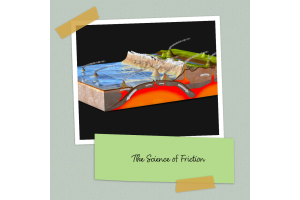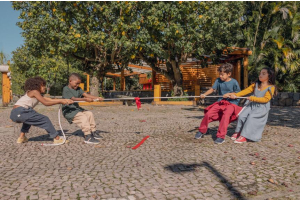Friction is everywhere

In winter, why does the road near the bus station in some cities turn dark gray after a heavy snow? It turns out that a thin layer of ash has been scattered there.
The effect of ash is obvious. Without it, it would be difficult for a moving car to stop; without it, it would be difficult for a stopped car to start. Why does ash have this effect?
Find a glass ball or a metal ball, and use a hardcover book or a smooth hard board (such as the writing pad) to build a ramp. Place the small ball gently at the top of the ramp. The ball will roll down automatically and roll on the smooth table for a distance before stopping. Now lay a layer of rough cloth under the ramp and do the experiment again. Then the ball will not roll very far before stopping. This experiment shows that the size of friction between two objects is related to the smoothness of the contact surface - the surface is smooth, and the friction is often smaller; the surface is rough, and the friction is larger. In places where we need to increase friction, we should make the surface rough. The ash on the snow is doing just this. The uneven patterns on tires and soles are also doing this. The frosted glass on the blackboard is used because its surface is uneven, which gives it a certain amount of friction. People can write on it and leave chalk marks. Similarly, in places where we do not need friction, we always want to make the surface of objects smooth.
we can do another friction experiment.
Find a thin iron wire and a piece of ice. Fix the ice block and pull the iron wire back and forth on the ice like a hacksaw. After a while, the iron wire cuts into one end of the ice block and comes out the other end.
Why can the iron wire cut into the ice block without teeth? It turns out that the friction between the iron wire and the ice plays an important role here. The heat generated by friction melts the ice block into water at the cut, so the iron wire can move slowly in the ice block.
Friction has made great contributions in human history. The Beijing ape-man 500,000 years ago had already learned to use fire. At that time, the fire was taken from the forest. Lightning struck dry trees in the forest, causing a fire. However, this opportunity is not common. In order to preserve the fire, the primitive people had to send people to guard the fire and constantly add firewood to the fire. Later, after many people's research, the methods of drilling wood to get fire and knocking stones to get fire were invented.
Humans created the method of getting fire, and entered a new era. Even in modern times, the match head also needs to be rubbed to generate heat to ignite, and the lighter also needs to be rubbed against the flint to produce sparks to ignite. We are still applying the principle of drilling wood to get fire.
The principle of friction can not only cut ice cubes, but also cut various hard things. The high temperature generated by friction can melt or soften the friction part until it is cut off. This principle is used in engineering and military.
Some factories have installed a toothless circular saw blade for cutting steel. This circular saw blade not only has no teeth, but is also made of relatively soft steel sheet. It has a water tank underneath (sometimes a water pipe can be installed on one side of the aluminum sheet to automatically spray water on the saw blade). When cutting steel, the saw blade rotates at a very high speed. A piece of 44 cm long and 8 mm thick steel can be sawed in 2 minutes.
You may ask, the saw blade and the workpiece are in intense friction, and the saw blade will also become soft due to heat. What should I do? There is a way! Use water to cool the saw blade. The flowing water will take away the heat on the saw blade at any time, so that the temperature of the saw blade will not be too high, so it will not become soft. But the steel has no cooling conditions, so the toothless saw can "cut iron like mud". The workpiece is stationary and the saw blade rotates, which is an important feature of the toothless saw. When the saw blade and the workpiece are in friction, in addition to heat generation, the two contact parts should also break or twist, and wear occurs, but in fact the saw blade wears very slowly. This is because the saw blade is rotating, and its contact points with the workpiece are scattered on the entire circumference, while the contact points between the workpiece and the saw blade are fixed, so the workpiece has much more chance to wear than the saw blade.
At the same time, it is also because the saw blade is a relatively soft steel sheet, which is not easy to break, and can be restored to its original shape after twisting and deformation. The workpiece is generally hard and brittle, and is easy to wear. This is the secret that the saw blade can "overcome the strong with the soft".
Friction can not only cut metal, but also weld metal. Welding copper and aluminum used to be a problem, and people used the principle of friction to generate heat to solve it: let the motor drive the copper part to rotate quickly, and then let the non-rotating aluminum part press against the rotating copper part under strong pressure. The friction surface of copper and aluminum will produce high temperature. Under the high temperature, the contact surfaces of the two metals will become soft, and the metal molecules will penetrate each other and recombine. After cooling, the two metals will become an inseparable whole. Frictional heat plays a major role in this process.
Frictional heat can bring benefits to people, but it can also cause trouble for people in many situations. For example, friction will cause machines to heat up and waste power, and also cause machine parts to wear and deform. In this case, people have to overcome those harmful friction forces and find ways to dissipate heat.
When a ship is sailing in the sea, it has to overcome the wet friction between the hull and the water. However, even with wet friction, the ship's sailing is not easy. A tugboat on the water is pulling a barge on a calm water surface. The tugboat is pulling the barge with force, but the barge does not seem to want to move, and the steel wire is pulled tight. Who is blocking the barge from moving forward? Is it just wet friction? The following experiment can help us find the reason.
Find a chopstick and a matchbox, insert the chopstick into the matchbox, and light a stick of incense. Please hold the matchbox up with one hand and hold the lit incense with the other hand, placing the incense in front of the matchbox. If there is no wind in the room, the smoke from the incense will rise vertically. At this time, you blow a stream of air towards the matchbox with your mouth, and you are surprised that the smoke from the incense actually blows towards the direction of the airflow and drifts towards the back of the matchbox. What is going on?
The smoke drifts to the back of the matchbox, indicating that the air pressure behind the matchbox is relatively low, so the surrounding air rushes there, and the smoke drifts there. To explain it in physics, a vortex is formed behind the matchbox.
If you blow with a relatively small force, the speed of the airflow is very small, and the smoke will not drift to the back of the matchbox. Only when you blow hard will this phenomenon occur. This also shows that a certain speed of airflow can form a vortex.
Motion is relative. The airflow blowing on the matchbox and the matchbox moving in the air are the same in nature. A large square box-shaped "bread truck" is driving fast in the air, and a vortex will form behind it, causing dust to fly.
Why does a vortex form?
When an object moves quickly, the air in front of it cannot move around to the back in time, causing a temporary region of near-vacuum behind the object. When this region appears, the air around it will scramble to fill it, forming a vortex.
The air pressure is low in the vortex, so for a moving object, the pressure in front is much greater than the pressure in the vortex at the back, just like a strong man pushing back in front of the car and a little child pushing forward in the back. Together, they form a backward force, which is related to the vortex. We call it vortex resistance.
In short, the resistance of a moving object includes friction resistance and vortex resistance.










